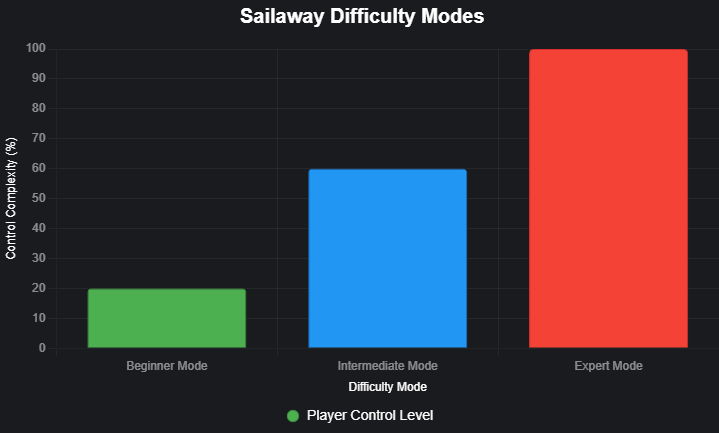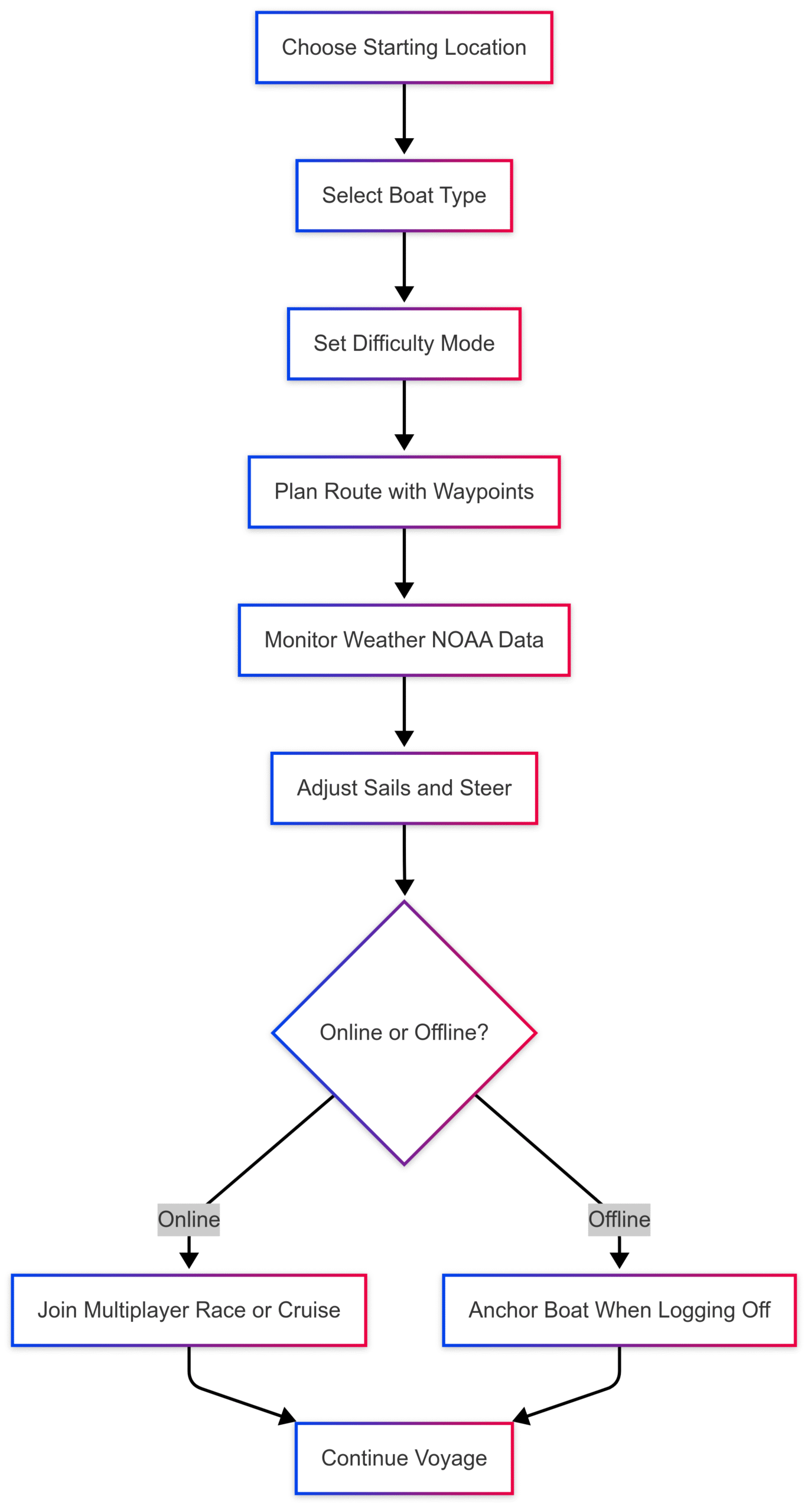Sailaway: The Sailing Simulator Review
Explore Sailaway: The Sailing Simulator, a realistic PC sailing sim with global navigation, real-time weather, and multiplayer races. Is it worth it?
Sailing captures the imagination with its promise of freedom, adventure, and the challenge of mastering wind and water. For those who dream of navigating the seas but lack access to a boat or the time to learn in real life, sailing simulators like Sailaway: The Sailing Simulator offer a compelling alternative. Developed by Orbcreation, Sailaway aims to deliver an authentic sailing experience on PC, complete with real-world weather, a persistent global map, and a variety of boats. But does it live up to its promise of being the most realistic digital sailing experience? This in-depth review explores Sailaway’s features, gameplay, strengths, and limitations, while comparing it to other sailing simulators and assessing its value for both novice and experienced sailors.
What Is Sailaway: The Sailing Simulator?
Sailaway is a PC-based sailing simulator available on Steam, designed to replicate the complexities of sailing with a focus on realism. Unlike arcade-style sailing games, it emphasizes authentic physics, real-time weather data from the National Oceanic and Atmospheric Administration (NOAA), and a persistent online world that mirrors Earth’s geography. Players can sail a range of vessels—from small daysailers to high-performance racing boats and ocean-going cruisers—anywhere in the world. The simulator supports both single-player exploration and multiplayer racing, making it versatile for different playstyles.
The game’s standout feature is its persistent world, where time, weather, and wind conditions are synchronized for all players. This creates a shared environment for races and long-distance voyages, allowing players to undertake epic journeys, like sailing from Seattle to Honolulu, without needing to stay glued to their screens. However, this realism comes with trade-offs, particularly for those seeking a more casual or offline experience.
Gameplay and Features
A World of Sailing Possibilities
Sailaway offers an open-world sailing experience, with a map that encompasses the entire globe. Players can start their journey anywhere, from the calm waters off Maui to the busy harbors of Northern Europe. The game uses real-world map data, ensuring accurate coastlines and ocean depths, though land-based structures are simplified or procedurally generated. For example, iconic landmarks like the Fehmarn Sound Bridge are absent, which may disappoint players expecting detailed terrestrial environments.
The persistent world operates in real time, meaning a trans-Pacific crossing can take months, just as it would in reality. Players can log off, and their boat’s position updates based on wind and current conditions, allowing for long-term voyages. This feature appeals to players who enjoy planning and executing extended journeys, such as sailing from Lübeck, Germany, to Malmö, Sweden, as one user described in their experience starting in Travemünde.
Boat Selection and Customization
Sailaway offers a variety of boats, catering to different skill levels and sailing goals. Here’s a breakdown of the main boat types available:
| Boat Type | Description | Best For |
|---|---|---|
| Mini-Transat | A small, agile daysailer for quick coastal trips. | Beginners, casual sailing |
| Cruiser (e.g., 38’ Catamaran) | A stable, spacious vessel for long-distance ocean voyages. | Long-distance cruising |
| Racing Boats | High-performance vessels like the 50’ Racing Yacht for competitive sailing. | Multiplayer races, advanced users |
Players can customize their boats, adding personal touches like home port names or national flags displayed on the stern. This feature enhances the role-playing aspect, allowing players to feel a connection to their virtual vessel. For example, one player noted the satisfaction of seeing “Lübeck” on their boat, mirroring their real-world hometown.
Realistic Physics and Weather
Sailaway prides itself on its physics engine, which simulates wind, currents, and sail dynamics with high fidelity. The game pulls real-time weather data from NOAA, ensuring that conditions like wind speed, wave height, and cloud cover match those at the chosen location. This creates immersive scenarios, such as navigating stormy seas or enjoying a calm sunset sail. However, the real-time weather can be a double-edged sword. Players expecting a sunny afternoon off Maui might find themselves in pitch-black skies or heavy seas, with no option to adjust conditions unless they wait hours for the weather to change.
The day-night cycle and dynamic water visuals add to the immersion. Waves respond to wind data, and seagulls appear near land, enhancing the sense of place. These details make Sailaway visually appealing, though the lack of detailed land structures can break immersion for some.
Multiplayer and Racing
The persistent online world shines in multiplayer mode, where players can join scheduled races or host custom ones. Races use the same weather and wind conditions for all participants, ensuring fair competition. However, like iRacing, races are scheduled in advance, requiring players to plan their sessions. For those unable to commit to fixed times, practicing alone or setting up private races is an option.
The racing experience is hindered by the absence of right-of-way rules enforcement, a critical aspect of real-world sailboat racing. Without judges or clear guidelines, disputes over racing etiquette can arise, limiting the competitive depth. Additionally, the lack of a tutorial for racing makes it challenging for newcomers to find starting lines or understand race mechanics.
Difficulty Settings and Tutorials
Sailaway caters to a wide range of skill levels through adjustable difficulty settings:
- Beginner Mode: The game handles most sail adjustments, allowing players to focus on steering. Ideal for novices or casual players who want a relaxed experience.
- Intermediate Mode: Players control sails and steering, with on-screen hints (e.g., “Take in one reef on the mainsail”). This mode suits those with some sailing knowledge.
- Expert Mode: Full manual control, requiring in-depth understanding of sail trim and navigation. Best for experienced sailors.
The included tutorials are brief but sufficient to get beginners started. They cover basics like sail handling and navigation, though some players find them fast-paced and recommend supplementing with YouTube tutorials for deeper learning.
Controls and Accessibility
Control Challenges
One of Sailaway’s biggest hurdles is its control scheme. Sailing a complex vessel typically requires multiple inputs—adjusting sheets (ropes), steering, and monitoring the environment. In real life, this is a physical task, but on a PC, it’s limited to keyboard and mouse inputs, which can feel clunky.
- Mouse-Only Controls: Clicking and dragging to adjust sheets is awkward, as players must pan the camera to locate ropes. Clickpoints are hard to find, and the motion is unintuitive.
- Keyboard and Mouse Combo: Using the keyboard for sail adjustments and the mouse for camera control is more manageable but still feels unpolished.
- Game Controller Support: Available but not widely preferred, as it doesn’t fully address the complexity of sail management.
The developers have considered adding TrackIR support for easier camera control, but its limited rotational range may not suffice. Virtual Reality (VR) could be a game-changer, offering intuitive head tracking and immersive controls, but it’s not currently on the roadmap. For comparison, MarineVerse Cup leverages VR effectively, providing a more intuitive sailing experience.
Accessibility for Beginners
Despite its complexity, Sailaway is approachable for beginners thanks to its difficulty settings and tutorials. The intermediate mode, with its helpful hints, allows novices to learn sail trim and navigation without being overwhelmed. However, the lack of detailed feedback on advanced techniques, like optimizing sail shape, can leave aspiring sailors reliant on external resources.
Strengths of Sailaway
- Realism: The physics engine and NOAA weather data create a convincing sailing experience, especially for long-distance cruising.
- Global Map: The persistent world allows for epic voyages across oceans, with accurate geography and real-time conditions.
- Multiplayer: Scheduled races and shared weather make competitive sailing engaging for dedicated players.
- Customization: Personalizing boats with flags and home port names adds a role-playing element.
- Flexible Difficulty: From beginner-friendly automation to expert-level manual control, Sailaway caters to diverse skill levels.
Limitations and Gaps
- Control Issues: The keyboard and mouse setup struggles to handle the complexity of sail management, detracting from the experience.
- Incomplete Simulation: Key aspects of sailing, like provisioning, anchoring, and docking, are absent or simplified. Capsizing, a real-world risk, is not modeled.
- Visual Monotony: Long-distance cruises can feel visually repetitive, with vast stretches of ocean offering little to see.
- Racing Limitations: The lack of right-of-way rules and racing tutorials hinders the competitive experience.
- Persistent World Drawbacks: Real-time weather and time zones can frustrate players seeking specific conditions, with no offline mode to adjust them.
Comparison with Other Sailing Simulators
To understand Sailaway’s place in the market, let’s compare it to other popular sailing simulators: eSail Sailing Simulator, MarineVerse Cup, and Sail Simulator 5. Below is a comparison table:
| Simulator | Key Features | Strengths | Weaknesses | Price (USD) |
|---|---|---|---|---|
| Sailaway | Persistent global map, real-time NOAA weather, multiplayer races, customizable boats | Realistic physics, long-distance cruising | Clunky controls, limited docking/anchoring | $39.99 (Steam) |
| eSail | Coastal sailing focus, detailed tutorials, mooring/anchoring practice | Beginner-friendly, strong tutorials | Limited offshore sailing, no Steam Deck support | $37.99 (Steam) |
| MarineVerse Cup | VR and non-VR modes, casual sailing, racing focus | Intuitive VR controls, fun racing | Less realistic physics, simplified mechanics | $19.99 (Steam) |
| Sail Simulator 5 | Realistic sail/water physics, editable skins, AI-assisted sailing | High-fidelity physics, customizable | Dated graphics, less global exploration | $19.90 (Stentec) |
eSail Sailing Simulator
eSail excels as a virtual sailing school, offering detailed tutorials and practice for coastal sailing tasks like mooring and anchoring. It’s ideal for beginners or those focused on near-shore sailing. However, its world is smaller than Sailaway’s, and it lacks the same level of offshore exploration.
MarineVerse Cup
MarineVerse Cup stands out for its VR support, making it more immersive for players with headsets like the Oculus Quest 2 ($299). Its controls are intuitive, especially in VR, but the physics are less detailed than Sailaway’s, and it leans toward casual racing rather than simulation.
Sail Simulator 5
Sail Simulator 5 by Stentec offers highly realistic sail and water physics, with AI assistance for beginners. Its graphics are dated, but the ability to edit boat skins adds personalization. It’s a strong alternative for those prioritizing physics over global exploration.
User Experiences and Community Feedback
The sailing simulation community, as seen in forums and Steam reviews, offers valuable insights into Sailaway’s appeal. Many users appreciate its realism and global map, with one player describing their journey from Travemünde to Lolland, Denmark, as a relaxing way to explore while chatting with friends. Others praise its potential as a learning tool, with one user noting that eSail helped them feel more confident docking a real 27-foot boat.
However, frustrations with Sailaway’s controls and incomplete simulation are common. The lack of docking or anchoring mechanics disappoints players who want a full sailing experience. Some recommend eSail for beginners or MarineVerse Cup for VR enthusiasts, while others suggest real-world alternatives like remote-controlled sailboats to learn fundamentals without a PC.
Visualizing the Sailing Experience
To illustrate the progression of difficulty in Sailaway, here’s a chart showing how player control increases with each mode:

This chart highlights how Sailaway scales from minimal control in Beginner Mode to full manual operation in Expert Mode, catering to a wide audience.
Chart: Sailing Workflow
To visualize the process of planning a voyage in Sailaway, here’s a flowchart:

This flowchart outlines the steps from selecting a location to continuing a voyage, emphasizing the game’s persistent nature.
Pricing and Availability
Sailaway is available on Steam for $39.99, with a free demo version for players to test basic features. The full version includes access to all boats and the global map. For comparison:
- eSail: $37.99 (Steam)
- MarineVerse Cup: $19.99 (Steam, VR version available on Oculus for similar pricing)
- Sail Simulator 5: $19.90 (Stentec website, Deluxe version)
Sailaway’s price is on the higher side, reflecting its ambitious scope, but the control issues and missing features may make competitors like eSail or MarineVerse Cup more appealing for some.
Who Is Sailaway For?
Sailaway is best suited for:
- Sailing Enthusiasts: Those with real-world sailing experience who want to practice navigation or plan long-distance routes.
- Simulation Fans: Players who enjoy realistic simulators and are willing to invest time in learning complex mechanics.
- Multiplayer Racers: Competitive players who can commit to scheduled races and enjoy the challenge of real-time weather.
It’s less ideal for:
- Casual Players: The clunky controls and lack of instant gratification may frustrate those seeking a relaxed experience.
- Beginners Without Patience: While tutorials help, the learning curve can feel steep without external resources.
- Offline Players: The persistent world’s reliance on real-time conditions limits flexibility for solo play.
Conclusion
Sailaway: The Sailing Simulator offers a unique blend of realism and ambition, with its global map, real-time weather, and persistent world setting it apart from competitors. Its physics engine and customizable boats create an immersive experience for dedicated sailors, while the multiplayer races add a competitive edge. However, clunky controls, missing features like docking and anchoring, and the visual monotony of long voyages hold it back from being the definitive sailing simulator.
For those intrigued by the idea of sailing the world from their PC, Sailaway is a solid choice, especially at its $39.99 price point on Steam. However, beginners may prefer eSail for its tutorials, and VR enthusiasts might gravitate toward MarineVerse Cup. If you’re curious, try the free demo to see if Sailaway’s blend of realism and role-playing suits your virtual sailing dreams. For now, it remains a promising but imperfect voyage across the digital seas.
Happy Boating!
Share Sailaway: The Sailing Simulator Review with your friends and leave a comment below with your thoughts.
Read Sail Names: Explained for Beginners (With 15 Examples) until we meet in the next article.






